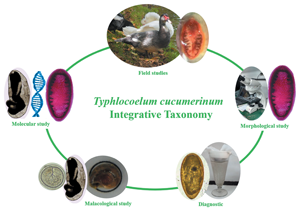Article contents
Identification of the avian tracheal trematode Typhlocoelum cucumerinum (Trematoda: Cyclocoelidae) in a host–parasite–environment system: diagnosis, life cycle and molecular phylogeny
Published online by Cambridge University Press: 09 June 2021
Abstract

Typhlocoelum cucumerinum is a tracheal parasite of birds widely distributed across the globe. Nevertheless, aspects of the biology of this cyclocoelid are still poorly understood. Herein, we report the finding of T. cucumerinum in definitive and intermediate hosts from an urban waterbody of Brazil. The parasite was initially detected during the necropsy of domestic Muscovy ducks (Cairina moschata) found dead in the locality. Coproparasitological tests in live animals revealed that 12/47 (25.53%) Muscovy ducks and 2/8 (25%) mallards (Anas platyrhynchos platyrhynchos) were infected with T. cucumerinum. Moreover, rediae and metacercariae morphologically similar to T. cucumerinum were found in 3/248 (1.33%) Biomphalaria straminea collected in the same waterbody frequented by the birds. The conspecificity between the adult and the larval stages was confirmed molecularly (100% similarity in Cox-1). Moreover, the phylogenetic position of T. cucumerinum was determined for the first time based on partial fragments of the 28S, Cox-1 and Nad-1 genes. The species grouped with other members of the subfamily Typhlocoelinae with sequences available, but the data obtained do not support the distinctiveness of the genera Typhlocoelum and Tracheophilus. Further studies involving a broader range of species can result in taxonomic rearrangements in Typhlocoelinae.
- Type
- Research Article
- Information
- Copyright
- Copyright © The Author(s), 2021. Published by Cambridge University Press
References
- 5
- Cited by




